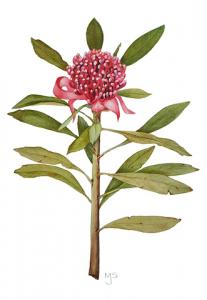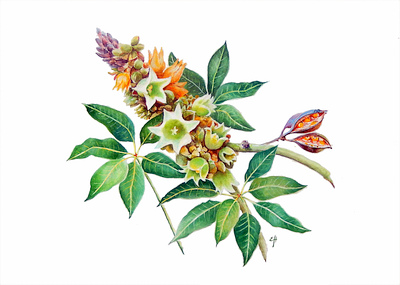 |
| 1. The Hunters Enter the Woods |
Unicorns have been rather co-opted into the (predominantly female) childish world of sparkly pink and rainbows. But they used to be magical creatures of mystery and influence. And they used to symbolise, among other things, chivalry, purity and Christianity.
A famous series of seven tapestries, The Hunt of the Unicorn or La Chasse à la licorne, dates from the late Middle Ages and shows a group of noblemen or hunters in pursuit of a unicorn through an idealised French landscape. The tapestries were woven in wool, metallic threads, and silk - the vibrant colours were produced from dye plants: weld (yellow); madder (red) and woad (blue). They were probably woven between 1495 and 1505 in Brussels, which was an important centre of the tapestry industry in Medieaval Europe. Whereas wool was widely produced in the rural areas around Brussels, and a common primary material in tapestry weaving, the silk was costly and hard to obtain, indicating the wealth and social status of the owner.
First recorded in 1680 in the Paris home of the Rochefoucauld family, the tapestries were looted during the French Revolution, rediscovered in a barn in the 1850s, and now hang in The Cloisters in New York. The tapestries themselves are the subject of intense scholarly debate about the meaning of their iconography, the identity of the artists who designed them, and even the order in which they are meant to be hung. Although various theories have been put forward, there is no definitive answer as to their provenance, and their dramatic but conflicting narratives have inspired multiple readings.
 |
| 2. The Unicorn is Found |
According to Wikipedia, "One theory is that the tapestries show pagan and Christian symbolism. The pagan themes emphasise the medieaval lore of beguiled lovers, whereas Christian writings interpret the unicorn ad its death as the Passion of Christ. The unicorn has long been identified by Christian writers as a symbol of Christ. conscripting the traditionally pagan symbolism of the unicorn. The original pagan myths about The Hunt of the Unicorn refer to an animal with a single horn that can only be tamed by a virgin; Christian scholars translated this into an allegory for Christ's relationship with the Virgin Mary".
In Gothic tapestry, the makers considered biblical events as 'historical' and linked the biblical and secular narratives in the tapestry weaving. Medieaval art illustrated moral principles, and the tapestries used narrative allegories to illustrate these morals. The secular unicorn hunt was not simply Christian art, but also an allegorical representation of the Annunciation.
 |
| 3. The Unicorn is Attacked |
There is some speculation that the unicorn tapestries were commissioned to celebrate a marriage - as medieaval poets connected the taming of the unicorn to the devotion and subjugation of love. The taming of the unicorn, therefore, symbolises the secular lover who was enchained by a virgin and trapped in the fence (in the tapestry The Unicorn in Captivity) - this all seems rather brutal and dominating, but apparently the concept of an overlapping God of Heaven and God of love was accepted in the late Middle Ages.
Different interpretations lead to different titles and different sequences in which it is suggested the tapestries should be hung. The tapestries are different sizes and some suggest that they were designed for use as a bedroom ensemble, with the five large pieces fitting the back area of wall, while the other two pieces serve as the coverlet or overhead canopy. Others contend that the first and last may be independent works or form a different series entirely.
 |
| 4. The Unicorn Defends Itself |
Whatever the interpretation, the tapestries are glorious and rich in floral imagery, featuring the 'millefleurs' background style of a variety of small botanic elements. Invented by the weavers of the Gothic age, this style became popular during the late Medieaval era and declined after the early Renaissance. There are more than a hundred plants represented in the tapestries, scattered across the green backgrounds of the panels, most of which (85) have been identified by botanists according to a paper published in 1983. This paper maintains that the particular flowers featured in the tapestries reflect the tapestries' major themes and represent not only a secular, physical, enclosed garden (hortus conclusus), but also a connection with the Annunication.
 |
| 5. The Mystic Capture of the Unicorn |
If these tapestries look familiar, they probably are. Replicas of them can be found in all sorts of places in film and television, ranging from Spiderman: Far from Home to Family Guy and Once Upon a Time. They appear in the 1988 film, Some Girls, the 1993 film, The Secret Garden, and a French advert for cheese. Children's authors, science fiction short story writers, folk musicians and Leonard Cohen have all woven them into their artistic creations. In Harry Potter and the Half Blood Prince, the last tapestry in the series, The Unicorn in Captivity, is seen in the various common rooms (Gryffindor, Slytherin, Ravenclaw and Hufflepuff) with different-coloured backgrounds.
 |
| The Unicorn is Killed and Brought to the Castle |
And now there are fantastic recreations adorning the walls of the Queen's Inner Hall at Stirling Castle, after a thirteen-year project to reweave the tapestries. They were never known to have been in the castle, but there is thought to have a been a series like it. Only the very wealthiest of people could afford tapestries, and an inventory shows that James V had a large collection including two sets which showed unicorns. A two-million-pound project saw two teams of three weavers recreating the tapestries and results in visitors to Stirling Castle being able to imagine something of the atmosphere of Scotland's royal court.
An exhibition at the castle tells the story of the recreation and explains how the tapestries were worked in the Medieval way, using a technique whereby the warp thread comes down, the weft thread is picked out, threaded through the warp, and packed down with the bobbin - I love the terminology as much as the painstaking process (The Unicorn in Captivity alone took two years to weave, working from right to left) and watching a video of the intricate art is truly incredible.
To develop a greater understanding of the thread types, colour palette and weaving techniques used by the original weavers, several hundred samples were made by the weavers of the new Hunt of the Unicorn tapestries. The sample of a single hunter's knee on the bottom row was the first sample to be made and was woven at eight warps per centimetre, which is the warp count of the original 15th Century tapestries. This was done to calculate the commission cost of the full set of seven tapestries. The adjacent sample of two knees was woven at four warps per centimetre (which is what was used for the new tapestries) and saved thirteen years of production time.
 |
| Some of the threads on bobbins |
In the sample showing two knees the blending of colours in the left knee uses a traditional technique: separate threads of different colours are combined to create different tones. The blending of colours on the right knee has been made using a contemporary method where different coloured threads are blended together before weaving. The whole thing is quite remarkable and I felt extremely humbled by the dedication and the magnitude of the project. My little cross-stitches are nothing in comparison, but I still love the focus on a small section of canvas which, with individual stitches, brings an image to life. I'm sure that has to be a metaphor for something... Life's rich tapestry, perhaps?
 |
| Blue and green should never be seen... |




